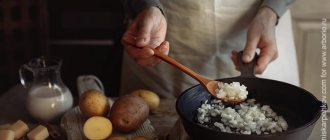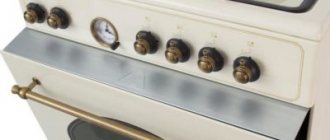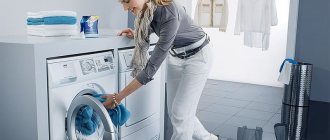Posted on Feb 19th, 2022,
by Chief Milkman
Categories:
- Pancakes, pancakes
- Cooking tips
The unsightly-looking Russian pancake is not as simple as it seems. To bake a tender, soft, thin, golden round with many through holes, you may have to try more than a dozen recipes and change a couple of frying pans. The ability to bake successful pancakes comes only with experience. It happens that you do everything according to a well-known recipe, but the dough does not bubble, the pancakes end up torn, not baked, turn out dry and break during the folding process. And sometimes, on the contrary, you put everything “by eye” and the baked goods come out great.
I have collected for you all the main problems that you may encounter when baking pancakes, and, of course, ways to solve them. Let's get started?
We tell you why pancakes tear and stick to the pan when turning over, and how to avoid this
It's a shame when a beautiful, delicate pancake breaks when you try to turn it over. And it’s even more offensive when this is repeated over and over again. Let's figure out what to do to prevent the pancakes from tearing.
Dough consistency
Properly mixed pancake batter should be pourable, homogeneous, without a single lump, and enveloping. This consistency can only be achieved by maintaining a balance of liquid and bulk ingredients. But if you overdo it with flour, don’t be upset, because you can always add water or milk to dilute the mixture to the desired thickness.
And if the dough, on the contrary, turns out to be too liquid, you can thicken it with flour.
Don't forget to let the finished dough “breathe.” Leave it for 15-30 minutes at room temperature so that gluten is released from the flour, which will increase elasticity and density. This will ensure the pancakes are strong and won't tear when you flip them.
Amount of sugar
Even if you are baking a sweet version, you should not add more granulated sugar than indicated in the recipe. With a high sugar content, the bottom side of the pancake will quickly begin to burn, sticking to the pan, while the top will still remain raw. Therefore, if you try to turn the pancake over with a spatula, you will most likely tear it.
More on the topic:
Openwork thin pancakes with beautiful holes made with milk and kefir - the most delicious recipes
Don't forget the oil
Vegetable oil added directly to the dough will give the pancakes plasticity and strength. They will also be easier to remove from the pan without sticking. But be careful: excess fat will cause the baked goods to burn.
In addition, the frying pan also needs to be greased with oil. It is convenient to do this with a special culinary brush or, as our grandmothers and mothers did, prick half a potato or onion on a fork and, dipping it in oil, apply it to the frying pan. The layer of fat should be as thin as possible. You can use a paper towel to remove excess.
Instead of vegetable oil, you can use a piece of fresh (unsalted) lard to lubricate the surface of the frying pan. If the frying pan is new or does not have a non-stick coating, it must be greased before baking each pancake. Do not forget that you need to cover not only the bottom, but also the sides with fat, then the pancakes will definitely not stick, and you will not have to make any effort when turning them over.
Lack of eggs
It's also possible that you didn't add enough eggs. It is this component that is “responsible” for viscosity and connects all other ingredients to each other. But you shouldn’t put too many eggs - the texture of the pancakes will be too dense and lose their tenderness.
Wrong cooking temperature
If you don't heat the pan enough and pour the first portion of dough onto it, it will come together when you turn it over. It is best to bake on medium heat or slightly above medium. If the heat is set too high, the baked goods will burn. But due to the low power of the burner, the pancakes will not be baked, but dried, as a result of which they will turn out brittle and dry. An exception is yeast pancakes; they should be baked at low heat.
You should also pay attention to the correspondence of the diameter of the burner to the diameter of the frying pan. If the fire is concentrated at the very edge of the pan, the pancake will not cook well in the center. Conversely, using a small burner will leave the edges raw while the center begins to burn.
It is better to dilute milk or kefir
Pancakes mixed exclusively with milk (cream, kefir, yogurt) will burn, stick to the pan and subsequently tear. To prevent this from happening, you need to dilute the dairy product with plain water in a ratio of 3 to 1 or even 2 to 1.
Unsuitable frying pan
Ideal pancakes are made in a cast iron frying pan with a thick bottom, but modern frying pans with non-stick coating are in no way inferior to the good old classics. It is advisable not to use the pancake pan for preparing other dishes; wash it only by hand, without detergents.
To prevent the pancakes from sticking to the new frying pan, it should be prepared. To do this, you need to pour regular table salt into it - so much so that the bottom is evenly covered. Heat the pan until the salt layer turns light brown. After this, you can pour it out and start baking.
Untimely turning over
You need to turn the pancake over only when its edges become golden, dry well, and the rest of the surface becomes matte, there is no wet dough left. Uncooked baked goods are more likely to tear when you pry them with a spatula.
Lots of leavening agents
If you add a large amount of soda or baking powder, the dough will become “weak” and lose strength and elasticity. For 1 liter of liquid, it is enough to put a small pinch, literally on the tip of a knife. Excess soda will also worsen the taste of baked goods.
Turning method
When it comes time to flip the pancake, you need to carefully separate its edges from the pan with a spatula or knife. Then pry it in the middle and in one movement sharply turn it over to the other side. Some housewives find it more convenient to turn pancakes by hand. First, you should also go along the edge with a spatula, and then take the pancake by one edge with your fingertips and turn it over. To avoid getting burned, you need to wear gloves.
It is very convenient to use a spatula with a silicone tip; wooden or metal tools are also suitable. But keep in mind that metal will scratch the non-stick coating, so it can only be used on cast iron pans.
More on the topic:
Kefir pancakes according to these recipes turn out thin, with openwork holes - try it!
Lots of oil in the frying pan
Before baking, it is recommended to grease the pan with oil and remove the remaining residue with a napkin. If the layer turns out to be plentiful, the pancake dough will shrink, will not bake well, and will tear when turned over or removed from the pan.
Tip 7 - lard
One of the oldest and most reliable tips is to grease the frying pan with an ordinary piece of raw lard. Place it on a fork and before each adding a new portion of pancakes, wipe the entire surface of the hot frying pan with lard. By the way, if it doesn’t start to heat, it means the frying pan is not warmed up enough - another defense against “clumpy pancakes”; there is time to warm up the frying pan. Believe me, the lard will melt exactly as much as is needed for one serving, there will never be too little or too much. In addition, this is the most economical way. You save on both butter and pancakes, which will no longer be lumpy.
What to do if the pancakes turn out dry and brittle?
When pancakes break, it is very difficult to beautifully roll them into a tube or fold them into an envelope to stuff them. Even if you succeed, when heated, the dough may burst or spread, and the filling will end up on the outside. Our advice will help you avoid this.
To prevent the edges of the pancake just removed from the frying pan from crumbling, you need to coat them with a piece of butter. And if you cover the stack immediately after cooking with another plate or cling film, the entire surface of the baked goods will become soft. After storing the pancakes in the refrigerator, you need to heat them in the microwave - then they will return to their former softness and elasticity.
To prevent pancakes from breaking, you need:
- add a moderate amount of sugar;
- put as many eggs as indicated in the recipe, excess protein contributes to fragility;
- put 1-2 tablespoons of potato or corn starch;
- add a little flaxseed flour;
- make the dough the consistency of liquid sour cream;
- add a few tablespoons of vegetable oil directly to the dough;
- let the dough rest for 20-30 minutes before baking;
- pour in a small amount of kefir, yogurt or other fermented milk product.
Let's figure out why pancakes come out hard and rubbery, and how to deal with it
Tender, soft, pancakes that melt in your mouth - they are so delicious! But if, after cooling, the baked goods become rough, become hard, and quickly become stale, there is probably an error in the cooking or storage technology. Let's figure it out.
Cooking method
It is best to knead the dough by hand - with a whisk. If you want to save time, you can use a mixer, but you should not turn it on at the highest speed. In this case, the mass will turn into a paste due to excessive release of gluten. For the same reason, you cannot use an immersion blender - the pancakes will turn out rubbery.
Too much flour and not enough baking powder
If you put too much flour into the dough and not enough baking powder or baking soda, it will turn out heavy. In order for the pancakes to come out tender and delicate, the pancake mass must be porous, visually airy, with many small bubbles. Baking powder or baking soda quenched with vinegar/lemon juice will help achieve this structure.
Regular boiling water will also help make the dough lighter and fluffier. It should be added in small portions, stirring vigorously with a whisk, when all components, including baking powder, have already been added.
If the dough is prepared only with water or full-fat milk
The optimal liquid for making pancakes is a mixture of water and milk or any fermented milk product. Dough made with only water or only full-fat (farmer's) milk usually turns out too viscous, with a heavy texture. After cooling, such pancakes become hard, and when bitten they stretch like rubber.
Type of flour
Special pancake flour will help solve the problem of hardness, density, and “rubbery” texture. Baked goods cooked on it will remain soft and tender even after cooling.
Reason #1 - incorrect dough consistency
It often happens like this: the housewife took a new recipe and decided to try it. She observed all the proportions, measured everything with spoons, kneaded the dough, heated the frying pan and greased it. But why do pancakes burn and stubbornly refuse to turn over to the other side?
It's all about lack of experience and errors in the recipe. Some housewives claim that different flours require different amounts of liquid.
The dough can be very thin or very thick. For thin pancakes you need a composition similar to liquid sour cream.
Solution
The error can be fixed simply:
- If the dough is thick, dilute it with the liquid with which it was kneaded (milk, kefir, water). It is better if the liquid is at room temperature or lukewarm.
- If the dough is liquid, then add flour without fear and mix thoroughly.
Pancakes are not baked and remain raw inside: reasons and ways to correct the situation
It also happens that a visually beautiful pancake - ruddy, openwork - remains sticky and uncooked inside. Why does this happen?
Dough made with kefir or sour milk
Pancakes made with any fermented milk product will always turn out slightly moist inside. To ensure they bake better, you must add baking soda. A looser texture with holes will allow the baked goods to “dry” better.
What if the dough is yeast?
It is also recommended to add a little soda to yeast pancakes, but just before baking, to the rested dough.
Thin frying pan
In a thin metal frying pan, the bottom layer of the pancake will begin to burn quickly, while the inside will remain raw.
Cold products
All ingredients must be removed from the refrigerator in advance so that they warm up to room temperature.
More on the topic:
Soft, thick, surprisingly fluffy pancakes made with kefir - very tasty
Too thick layer of dough
Pour the batter into a hot frying pan in a thin, even layer, tilting it in a circular motion with your wrist. When the pancake mixture turns out to be too thick, the pancakes will turn out thick and will not bake well.
Which frying pan to choose
The reason most often lies in the wrong frying pan. There is a special model for thin pancakes. These are thin and perfectly flat frying pans with low sides. Using this equipment, the entire pancake is baked evenly. The small diameter of the pan allows you to make a perfectly even circle of dough.
The best materials for frying pancakes are aluminum and cast iron. A thin fat layer forms on them, which prevents the dough from burning.
Before frying, dishes should be thoroughly washed and dried. Pancakes will burn and tear in an old frying pan with damage. That is why washing with abrasive sponges and powders is not recommended for devices. Any scratches lead to damage to the protective layer and regular burning of food.
Advice! The new frying pan must be sufficiently heated before frying the pancakes. At first, it is better to cook other dishes on it.
In addition to frying pans, stores sell special devices - pancake makers, designed for 6 small or 2 regular pancakes. The device is an aluminum plate with round recesses, coated with Teflon and connected to a heating element.
The pancake maker is plugged into the network, and its power is designed to provide the optimal temperature for frying pancakes. And thanks to Teflon, the dough does not stick and is easily removed. Often included are spatulas for turning and a measuring ladle for pouring the dough. The device makes frying quick and easy, so you should consider buying it if pancakes are the family's favorite breakfast.
Why do pancakes turn out without holes, how to make them openwork?
The problem is probably that the pan is not hot enough. The openwork texture is obtained upon contact with a very hot surface. Moreover, in this case, more holes are formed precisely when frying in a cast-iron frying pan without a non-stick layer.
You can also add a little boiling water to the prepared dough to make the pancakes holey and porous. But at the same time, the mass should initially be a little thicker so that the final consistency comes out normal.
Baking powder, including soda slaked with acid, will also help to achieve the delicacy of the products.
You can also first brew the flour with hot milk or water, and then add the rest of the ingredients - there you have the holes.
Why do pancakes sometimes turn out pale and not rosy?
To make the pancakes crispy and golden, you need:
- add enough sugar to the dough;
- heat the frying pan well;
- add butter (and with butter the pancake surface will turn out more golden and crispy than with vegetable oil);
- use a special pancake pan, without a/p coating.
Bon appetit!
Related posts:
- pancakes
- Maslenitsa
Chief milkman
I make healthy food tasty and vice versa.











